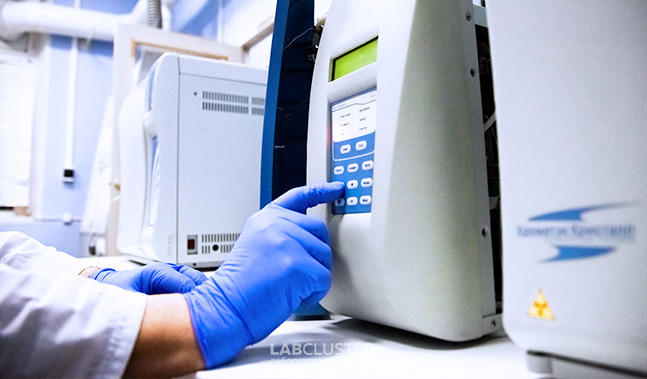Our accreditation area covers, in particular, the following exclusive and extremely complex analyses:
- dioxins (PCDD) and furans (PCDF) in atmospheric air, industrial emissions, soil, ground, deposits, waste, natural/drinking/waste water;
- tin-organic compounds in bottom deposits, soil, ground;
- polychlorinated terphenyls (PCTs) in deposits, soil, ground, drinking and natural water;
- microplastic in natural water and bottom deposits;
- saturated hydrocarbons (alkanes) C9 - C32 in bottom deposits and natural water;
- chronic and acute toxicity in natural/waste/drinking water, soil, ground, bottom deposits, waste;
- ethyleneglycol (EG), diethyleneglycol (DEG) in waste and natural water;
- volatile organic compounds (VOCs) in natural/drinking/waste water;
- methanol in soil, ground, waste and natural water;
- polyaromatic hydrocarbons (PAHs), organochlorine pesticides (OCPs) in bottom deposits, soil, ground, natural/drinking/waste water, marine fauna, atmospheric air;
- polychlorinated biphenyls (PCBs) in deposits, soil, ground, natural/drinking water/waste water, marine fauna;
- mass concentration of 2,4-dichlorophenoxyacetic acid/2,4-D herbicide in soil, ground, natural and drinking water
- benzene, toluene, xylenes, styrene in deposits, waste, soil, ground, natural/drinking/waste water;
- 226Ra, 232Th, 40K, 137Cs, 90Sr in soil, ground, deposits, marine fauna, vegetation;
- total alpha (Аα) and beta (Аβ) activity, 222Rn (radon), 137Cs, 90Sr in drinking and natural water
- rodanides in natural/drinking water/waste water;
- xanthagenates, malathion, fozalon, dimethoate, parathion-methyl, prometryn, simazine, atrazine, and propazine in natural and waste water;
- chlorophyll A (pigment index) in drinking and natural water, vegetation;
- pheophetin A, chlorophyll B, chlorophyll C1+C2, carotenoids in natural water and vegetation;
- a mixture of natural mercaptans in industrial emissions and atmospheric air;
- mass concentration of ethers in waste and natural water;
- organic carbon, cyanides, phenols in soil, ground, waste, natural and drinking water;
- CEC (cation exchange capacity), the amount of water-soluble toxic salts, the degree of base saturation (calculated from the sum of absorbed bases and hydrolytic acidity) in soil and ground;
- methane, gasoline in soil and ground;
- acrylic acid, methacrylic acid, methyl acrylate, methyl methacrylate, butyl acrylate, butylmethacrylate in natural water, soil and ground;
- degree of salinity, fluid index, index of plasticity, porosity, degree of salinity, degree of heterogeneity of granulometric composition, coefficient of water saturation, upper limit of plasticity (soil moisture at the limit of liquidity), lower limit of plasticity (soil moisture at the rolling-out limit) in soil and ground;
- tellurium, thorium, uranium, gold, holmium, indium, iridium, lanthanum, lutetium, neodymium, samarium, terbium, thulium, cerium, caesium, dysprosium, erbium, europium, gallium, gadolinium, germanium, hafnium, palladium, protactinium, platinum, rubidium, rhenium, rhodium, ruthenium, scandium, yttrium, ytterbium, zirconium in natural/drinking/waste water;
- arsenic, mercury, caesium, rubidium, barium, boron, yttrium, lanthanum, silver, scandium, thallium, tellurium, titanium, thorium, uranium, cerium in vegetation.






